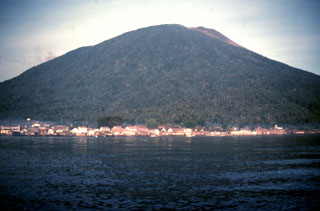Report on Gamalama (Indonesia) — February 1988
Scientific Event Alert Network Bulletin, vol. 13, no. 2 (February 1988)
Managing Editor: Lindsay McClelland.
Gamalama (Indonesia) Widespread ashfall; evacuations
Please cite this report as:
Global Volcanism Program, 1988. Report on Gamalama (Indonesia) (McClelland, L., ed.). Scientific Event Alert Network Bulletin, 13:2. Smithsonian Institution. https://doi.org/10.5479/si.GVP.SEAN198802-268060
Gamalama
Indonesia
0.81°N, 127.3322°E; summit elev. 1714 m
All times are local (unless otherwise noted)
Gamalama erupted on 12 February at 1830, spreading ash over a wide area of Ternate Island. No new lava flow accompanied the activity. VSI issued an aircraft advisory on 13 February, warning of potential hazards from the activity. The press reported that police and soldiers had helped evacuate ~ 1,500 residents of villages near Gamalama, added to ~ 2,000 people from the same area who had previously been evacuated to the neighboring island of Halmahera. Details of premonitory activity are limited, but relatively deep earthquakes had been recorded 18-19 January.
Geological Summary. Gamalama is a near-conical stratovolcano that comprises the entire island of Ternate off the western coast of Halmahera, and is one of Indonesia's most active volcanoes. The island was a major regional center in the Portuguese and Dutch spice trade for several centuries, which contributed to the extensive documentation of activity. Three cones, progressively younger to the north, form the summit. Several maars and vents define a rift zone, parallel to the Halmahera island arc, that cuts the volcano; the S-flank Ngade maar formed after about 14,500–13,000 cal. BP (Faral et al., 2022). Eruptions, recorded frequently since the 16th century, typically originated from the summit craters, although flank eruptions have occurred in 1763, 1770, 1775, and 1962-63.
Information Contacts: VSI; ANS; UPI.

